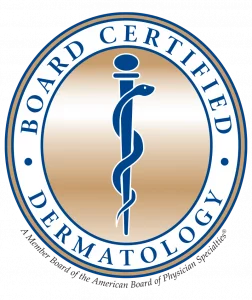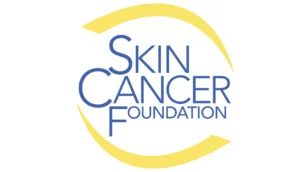Educational video created by the Society for Pediatric Dermatology
What is Eczema?
Eczema (AKA Atopic Dermatitis) is an itchy skin condition characterized by scaly red patches with bumps, oozing, and crusting. People suffering from eczema have intense itching relieved by scratching which produces secondary thickening of the skin. The hallmark of eczema is recurrence of itchy red skin in typical locations.
Eczema usually starts in childhood with more than 50% affected before one year of age, and 85% affected by five years of age. Although eczema often improves or resolves in many children over time, the disease may persist into adulthood. Those with more severe disease during childhood and those whose eczema started later in life have a higher likelihood of persistence.
What does eczema look like?
Infantile eczema (seen between birth and one year of age) is characterized by sudden onset of redness, scaling, crusting, oozing, rubbing and scratching. Lesions typically start on the cheeks and chin and scalp, and then spread to the trunk, outer arms and legs. There typically is sparing of the nose and diaper region. Many infants with eczema have difficulty sleeping due to itching.
Photos courtesy of Dermnet NZ

The childhood form of atopic dermatitis (seen between two years of age and puberty) and is characterized by chronic areas of scaly red patches typically on the antecubital fossa (i.e. front of the elbows), popliteal fossa (i.e. behind the knees), ankles and wrists, hands and feet. Facial involvement typically involves areas around the mouth (lip licking dermatitis), around the eyes, and corners of the ear lobes. In patients with darker skin types, atopic dermatitis may manifest as papular or follicular based lesions often with white discoloration (hypopigmentation). As in all forms of eczema, itching is a hallmark of the disease.
Photos courtesy of Dermnet NZ

The adult form of atopic dermatitis (which develops at puberty and extends into adulthood) will usually shows area of chronic scaly red patches on the wrists, hands, neck and ankles, and sometimes involvement on the face, back, and upper arms. Secondary areas of thickening and lichenification may be seen from scratching.
Photos courtesy of Dermnet NZ
How often should someone with eczema bathe? Can I swim if I have eczema?
There are no official guidelines which dictate the frequency with which patients with atopic dermatitis should bathe. Dr. Singer’s opinion is that patients with eczema should bathe once daily under the following conditions:
1. The cleanser must be a gentle fragrance free soap-less cleanser. Some suggestions include liquid Dove®, Cerave®, Vanicream® cleansing bar, and Cetaphil® cleanser. (Soaps such as Dial®, Ivory®, Irish spring®, etc. dry out the skin and should be avoided.)
2. The bath or shower should last no more than 10 minutes.
3. Upon exiting the bath or shower, pat dry lightly, trying to keep some water droplets on the skin.
4. Then immediately moisturize with either a cream or ointment (never a lotion) within three minutes of exiting of bathing/showering. – a regimen referred to as “soak and seal.“
Examples of moisturizers include Vaseline petroleum jelly, Aquafor Healing ointment, Cetaphil moisturizing cream, Cerave cream, Vanicream moisturizer, Aveeno eczema moisturizer, etc.
The addition of bleach to the bath water also known as a “bleach bath” has been recently shown to reduce colonization of bacteria on the skin which may flare eczema. Dr. Singer might discuss this treatment option with the patient if he feels this is necessary.
It is okay for patients with eczema to swim as long as the exposure to water is not prolonged more than 30 minutes. In addition, he/she must rinse off immediately after exiting the pool and apply a thick emollient within 3 minutes of exiting the pool.
What cleanser and moisturizer should I use?
Cleansers
Moisturizers
Laundry Detergent


What triggers eczema? What about food allergy?
Eczema may be triggered by a number of environmental factors including extremes in temperature and humidity. During the winter time, patients with eczema are more prone to dryness due to the lower humidity and cold temperatures. It is especially important to moisturize twice daily during colder months. On the flip side, during the summer, it is important to maintain an indoor temperature of 72°F as heat and sweating may exacerbate itch and eczema.
As mentioned above, harsh soaps can trigger eczema. In addition, bubble baths and fragrances should be avoided. To that end, it is advisable to use hypoallergenic detergents that are “free and clear ” and avoid fragrance, fabric softener, and dryer sheets. Perfumed and fragrance products from Bath and Body Works, Lush, etc. should also be avoided.Cotton clothing is preferable to wool and other harsh textiles, as these fabrics can irritate the skin.
Bacterial infection with Staphylococcus (Staph) is a common cause of eczema flares. People with eczema have impaired local immunity of the skin enabling bacterial colonization. These bacteria can drive over activity of the immune system with increased itching, redness, crusting, and oozing. Oral antibiotics are often necessary. Bleach bathes may decrease the bacteria on the skin.
The role of food allergy in patients with eczema is controversial. Although up to 35% of patients with severe eczema have food allergy, only a small percentage of these patients have food allergies relevant to their eczema. Recent studies support early introduction of peanut to reduce the incidence of peanut allergy. Those infants with moderate to severe eczema, however, should probably consult an allergist prior to introduction of peanut.
What are topical steroids? Are they safe to use?
Topical steroids are the first-line therapy for treatment of eczema. Many patients and their parents are fearful of using topical steroids due to potential side effects. Local side effects of topical steroids can include thinning of the skin, stretch marks, visible blood vessels, pimples, etc. However, if applied properly, topical steroids rarely produce local side effects. Topical steroids are graded as strong, mid-potency, and weak based upon vasoconstrictive assays.
Very strong steroids (e.g. Floucinonide) are only indicated for adults and children over 12 years of age. Areas of skin that have been scratched at frequently require strong topical steroids.
Medium Strength steroids(e.g. Triamcinilone 0.1% ) are used on thicker skin regions of the body such as the arms, legs, and trunk.
Low potency steroids (e.g. Desonide) are reserved for sensitive skin areas such as the face, armpits, groin and inner thighs. This class is often appropriate for infants.
Very weak steroids are found in over-the-counter preparations such as 1% hydrocortisone® Cortaid®. These are often too weak to control eczema.
In general, steroids ointments are more effective than creams and lotions because they are more occlusive. In addition, sometimes saran wrap or wet wraps are used to further occlude topical steroids to increase their potency.
The topical steroid is applied twice daily to active patches of eczema until the site is “itch free and flat.” What does “itch free and flat” mean? – It means that the active areas of eczema are no longer itchy to the patient and they feel smooth to the touch just like normal skin. Even if the skin looks discolored (i.e. lighter or darker in color ) it is considered to be “itch free and flat” as long as it is smooth to the touch and not itching. – At this point, the topical steroid is no longer applied every day. Instead, the patient may be instructed to apply topical steroid to the previous area of eczema 2 to 3 times a week (e.g. Mondays and Thursdays) in order to prevent flaring of the eczema. Twice-weekly application of appropriate strength topical steroid rarely produces injury to the skin. The reason is that the skin has a chance to recover during the other five days a week.
So the first goal is to calm down active areas of eczema until there is no more itching and the skin is smooth. The next phase of treatment is to maintain clear skin without producing side effects of the topical medications. Sometimes frequent use of moisturizers and avoidance of triggers is sufficient to maintain the skin; but other times, control of eczema may require twice weekly topical steroid, or non-steroidal anti-inflammatory medications such as Elidel, Protopic, or Eucrisa.
Finally it is important to remember that topical steroids should always be applied before application of moisturizers to ensure that the topical steroid penetrates the areas of eczema. The moisturizer is then applied to areas of normal skin (but not on top of the steroid).
In general, a very thin layer of topical steroid is typically applied to the skin, just enough to produce a nice shine to the skin. If one were to squirt a thin strip of cortisone cream from the last crease of the index finger to the tip of the finger (i.e a finger tip unit), this would provide enough cream to cover the size of one hand. It takes about 30 g of cream to cover an entire adult body.
Class I topical steroid (super high potency)
-Augmented betamethasone cream, ointment 0.05%
-Clobetasol dipropionate cream, ointment, foam 0.05%
-Desoximetasone 0.25% spray
Class II (high potency)
-Fluocinonide 0.05% cream, ointment
-Desoximetasone 0.25% cream, ointment
Class III/IV medium potency
-Triamcinilone 0.1% cream, ointment
-Fluticasone 0.005% ointment, cream
Class V (low medium potency)
-Hydrocortisone butyrate 0.1% cream, ointment
-Triamcinilone 0.025% cream, ointment
Class VI topical (low potency)
-Desonide 0.05% ointment, cream, foam
-Aclomethasone 0.05% cream, ointment
-Fluocinolone acetonide 0.01% cream, oil
Class VII (lowest potency)
Hydrocortisone acetate 1%, 2.5% cream, ointment
Do I have to use topical steroids? Are there other options?
Eucrisa is Not a steroid.
On March 25, 2020, the FDA approved Pfizer’s supplemental new drug application for Eucrisa ointment, 2%, for children as young as age 3 months with mild-to-moderate atopic dermatitis. In the study, Eucrisa was well tolerated and demonstrated effectiveness in patients with eczema with no new safety signals identified.
In December 2016, the FDA approved Eucrisa for the treatment of mild to moderate atopic dermatitis in adults and children older than two years of age.
Eucrisa reduces inflammation, redness and itching in eczema. The potency of Eucrisa is probably similar to a low potency cortisone cream. Unlike steroids, Eucrisa does not produce thinning of the skin, stretch marks or bruising. The main side effects are burning and stinging, particularly with the first and second applications. Often, Eucrisa is used in combination with topical steroids to help maintain control of eczema. Eucrisa may be used continuously on normal appearing skin.
Protopic and Elidel are NOT steroids.
Around 2002, Protopic and Elidel (AKA tacrolimus and pimecrolimus) became FDA approved for the treatment of eczema in children older than two years of age and adults. These agents have a long history of safety. These creams can be safely used anywhere on the body, including thin skin areas such as the groin, armpits and eyelids.
Elidel and Protopic reduces inflammation, redness and itching in eczema. Elidel and Protopic 0.03% are equivalent in strength to a low potency topical steroids, whereas Protopic 0.1% is equivalent to a mid-potency topical steroid.
Since Elidel and Protopic are not steroids, they do not produce local side effects that topical steroids do such as thinning of the skin, stretch marks, bruising etc. However, they have been associated with a stinging and burning sensation upon application which typically improves after using the medication for a week. Sometimes, topical steroids are used for several days first before the application of Elidel or Protopic in order to reduce burning and stinging sensations.
Elidel and Protopic are FDA approved for intermittent use, three times a week long-term, and are often used in conjunction with topical steroids.
In 2006, the FDA issued a black box warning regarding Elidel and Protopic with increased risk of lymphoma and skin cancer. These risks were mainly based upon patients ingesting these medications by mouth for transplantation and in animal studies where 30 times the human dose was used. Many human scientific studies since then have confirmed the safety of these topical therapies. Data over the past 10 years has not shown any increased risk of lymphoma or skin cancer with topical use of Elidel and Protopic. Finally, the American Academy of Dermatology has found no evidence to support the issuance of this black box warning.
Are there complications of eczema?
Eczema disrupts normal daily activities and sleep, family dynamics, and psychological well being. Severe eczema can lead to depression.
Scratching may lead to persistent thickening of the skin with further itching.
Discoloration of the skin (too light or too dark) is a frequent complication of eczema but is typically reversible once the eczema is fully controlled.
Patients with eczema are prone to secondary infections with bacteria and viruses. Overgrowth of Staphylococcus bacteria has been shown to produce flares of eczema. In addition, patients with eczema are also prone to secondary viral infections with molluscum contagiosum and herpes simplex virus.
Molluscum contagiosum has been known to flare eczema and spreads with scratching. Herpes simplex virus infection of eczema requires oral or intravenous systemic antiviral therapy.
And in addition, some patients with eczema may develop allergic contact dermatitis to topical creams, cosmetics, nickel, and even to topical steroids.
My eczema is really bad. Is there systemic treatment for eczema?
For those patients who don’t get better with topical treatments or whose eczema covers much of the skin, systemic treatments are necessary.
Light treatment (Narrowband UVB) is frequently used in psoriasis, and has been shown in some studies to be an effective treatment option for eczema as well. Light therapy is required two to three times a week until the eczema clears, and then long-term maintenance therapy is often required. Those with fair skin and blue eyes are at higher risk for long-term effects of light treatment. Unlike tanning salons, narrowband UVB has not been associated with increased risks of skin cancer.
Traditional oral systemic agents for eczema such as cyclosporine, methotrexate, and mycophenolate have been used “off label”for decades to treat severe eczema in children and adults. These treatments may produce substantial improvement of eczema. However, these medications may have side effects such as bone marrow suppression, immune suppression, irritation of the liver, kidney damage and high blood pressure.
More recently, improved understanding of the underlying cause of eczema has spurred the development of a new, safe and effective systemic treatment called Dupixent. This is a self administered injection (every 2 weeks) that addresses the itching and inflammation associated with eczema. By targeting a specific part of the immune system, Dupixent avoids the side effects linked to other systemic treatments. Currently, it is approved for patients 12 years and older, and trials are being conducted down to 6 years of age.
In 2017, Dupixent became the first systemic FDA approved therapy for moderate to severe atopic dermatitis. In the “SOLO 1” and “SOLO 2” studies, approximately 37% of patients with moderate to severe atopic dermatitis were clear or almost clear after 16 weeks of therapy. Since its release, Dupixent has shown even better results in clinical practice.
The most commonly reported adverse events in the treatment groups were injection site reaction (temporary redness and swelling) and pink eye (conjunctivitis). No patients dropped out of the study because of injection site reactions and one patient discontinued because of conjunctivitis. Note that pinkeye is often easily treatable with topical eyedrops.
Patients who start Dupixent should plan on remaining on this medication indefinitely as there is currently no cure for eczema.
Sources
- Paller, Amy S and Mancini T.; Hurwitz Clinical Pediatric Dermatology 4th edition
- Eichenfeld LF, Stein Gold LF. CME supplement to Dermatology News; Meeting the Challenge of Atopic dermatitis from Infancy to Adulthood released April 2017
- Eichenfeld et al. Guidelines of care for the management of atopic dermatitis, Section 2. Management and treatment of atopic dermatitis with topical therapies. JAAD 2014;71 116-132
- Simpson EL et al. SOLO 1 and SOLO2 investigators. New England Journal of Medicine 2016; 375; 2335 – 2348






















